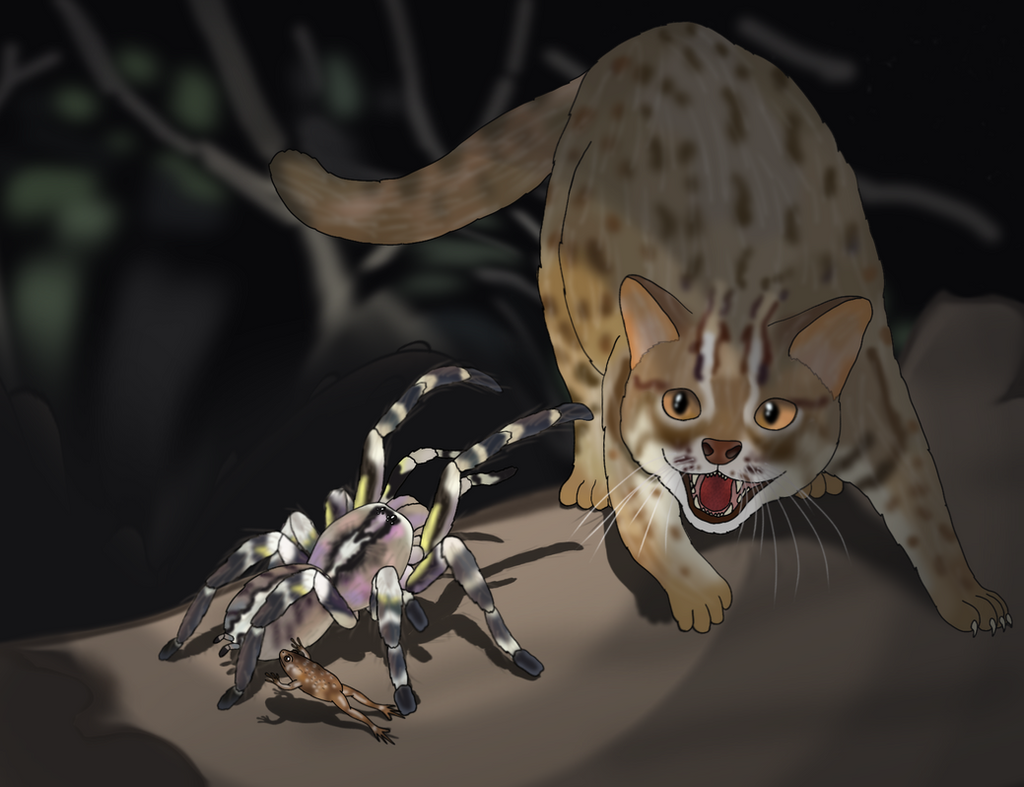HOME | DD
 Olmagon — Ornate Spotted Beasts
Olmagon — Ornate Spotted Beasts

#animal #cat #digitalart #datutorialcat #nationaltarantulaappreciationday #amphibian #animalart #animaldrawing #arachnid #endangered #endangeredspecies #felidae #flashlight #forest #frog #invertebrate #mammal #night #poecilotheria #spider #srilanka #tarantula #wilderness #wildlife #wildlifeart #prionailurus #carnivoran #internationalcatday #islandfauna #uperodon
Published: 2022-08-08 23:23:59 +0000 UTC; Views: 8310; Favourites: 145; Downloads: 4
Redirect to original
Description
During night in a Sri Lankan forest, a tiny rusty-spotted cat (Prionailurus rubiginosus) scrambles across the forest floor and small distances up trees in search of small animals to prey upon. The cat disturbs a Nagao's globular frog (Uperodon nagaoi) on a large branch, causing the frog to jump, and the movement is noticed by the cat which tries to pounce on it. However the frog is under the protection of a huge tarantula, an ornate tiger spider (Poecilotheria ornata), which raises its front legs and bares its fangs at the cat to try intimidating it, whilst the tiny frog takes shelter near the spider.Drawing made for International Cat Day and National Tarantula Appreciation Day, both of which are today (August 8), and also because I've been wanting to make another addition to my series of pictures involving large arthropods alongside small tetrapods to emphasize their size, along with this and this . Plus I do like drawing this type of art showing nocturnal scenes with a flashlight shining at them.
One of the smallest felids known, the rusty-spotted cat grows only 35 to 48 centimeters long (not counting the tail) and is found in the forests of India, Nepal and Sri Lanka. Like most other small wild cats, it is a nocturnal predator that eats mainly birds and rodents, but will eat just about any animal it can overpower. It hunts mainly on the forest floor but is known to be capable of climbing up trees. Because of its small size it makes a perfect candidate for me to draw alongside a large tarantula and really give a sense of the size of the arthropod, and it does indeed live alongside some of the largest spiders known.
Also called the fringed ornamental, the ornate tiger spider is a huge tarantula and one of the largest known spiders, with a leg span of up to 25 centimeters. The genus Poecilotheria (meaning 'spotted beasts') which it belongs to is found in India and Sri Lanka, with this species in particular being exclusive to the island nation of Sri Lanka, and the all members of the genus are arboreal (tree-climbing). Unfortunately no matter what I Google I cannot find out how high up Poecilotheria spiders live, though I have found in this paper that another arboreal tarantula, Iridopelma seladonium from South America, is found at heights of 1.5 to 2 meters up on plants, so I guess arboreal tarantulas as a whole probably don't climb very high (makes sense considering tarantulas are quite delicate and easily die from even a small fall). Also like other tarantulas, the ornate tiger spider does not spin webs for ensnaring prey. It instead lives in tree holes and crevices and eats small animals that walk past its hole. The bite of this large tarantula can cause great pain and medical issues in humans, but to date there are no known human deaths caused by its venom.
Quite interestingly, while it is a predator of small animals, the ornate tiger spider is known to share its tree hole homes with tiny, 3-centimeter frogs called Nagao's globular frogs (or Nagao's pug-snouted frogs, endemic to Sri Lanka like the spider) rather than kill and eat these small amphibians which they could surely overpower, and the two species have even been observed rearing their young and eggs in these tree holes together. This is believed to be mutualistic symbiosis, with the fanged tarantula protecting the defenceless frog from predators whilst the frog feeds on ants which could prey on the spider's eggs. Even more interesting is that a similar symbiotic relationship is also known in another tarantula and frog from South America (the Colombian lesser black tarantula and the dotted humming frog), so if I had a nickel every time a tarantula and frog developed mutualism, I'd have two nickels which is not a lot but it's weird that it happened twice.
Unfortunately all three animals shown in the picture are currently endangered, mainly due to habitat loss as deforestation destroys their forest homes. The rusty-spotted cat is also occasionally hunted for its skin or to protect livestock, and the tarantula is also quite regularly collected for the exotic pet trade (though because it may be a bit aggressive and has a bite that can cause medical issues, it isn't a recommended pet for beginners to tarantula keeping). More fortunately though, India and Sri Lanka have now both banned the trade and hunting of the rusty-spotted cat, and all Poecilotheria spiders are protected under CITEs Appendix II so permits are required to trade them internationally.
Related content
Comments: 18

👍: 0 ⏩: 1

👍: 2 ⏩: 0

👍: 0 ⏩: 0

👍: 0 ⏩: 1

👍: 0 ⏩: 1

👍: 0 ⏩: 0

👍: 1 ⏩: 2

👍: 1 ⏩: 0

👍: 2 ⏩: 0

👍: 0 ⏩: 1

👍: 1 ⏩: 1

👍: 0 ⏩: 0

👍: 0 ⏩: 0

👍: 1 ⏩: 1

👍: 0 ⏩: 1

👍: 1 ⏩: 0























